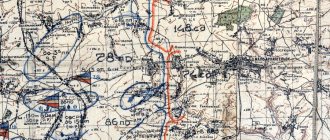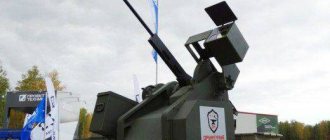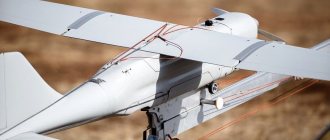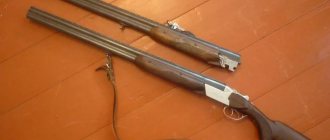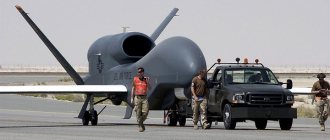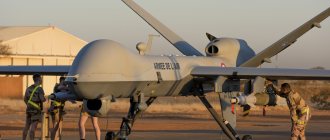Just 10-15 years ago, stories about combat drones could be classified as science fiction. But in 2005, Israel was the first to launch such devices; they were sent for reconnaissance purposes to Syria. The unmanned vehicles returned having received all the necessary information, and after a couple of hours the enemy’s air defense was eliminated. Since then, the development of UPL has been progressing by leaps and bounds. We present to your attention a review of the best drones in the world.
What can army UAVs do today?
The main tasks of military drones are reconnaissance and surveillance of enemy positions from above. They patrol the territory and guard routes. In addition, they can be used as gunners, with their help you can adjust fire. One of the smallest devices, the American Wasp, measures only 33 cm in length and weighs 200 grams. In 2008, when it was put into service, it cost 50 thousand dollars.
It costs much more to produce more powerful flying machines that can conduct military operations. Much more powerful devices are at least 100 times more expensive: those that can fight. They are capable of dropping bombs (for example, the Chinese WU-14 can deliver nuclear warheads across the continent) and can also fire missiles. In addition, flying machines play the role of kamikazes - they fall on the target, exploding and destroying the enemy.
Israel has become a pioneer in the use of drones for self-detonation. The Nagor combat vehicle produced by this country was used by Azerbaijan during the conflict in Nagorno-Karabakh in the fall of 2020.
Aircraft testing
Even before the creation of the demonstration model, the onboard avionics for the Okhotnik UAV were tested on prototypes of the PAK FA (T-50), and a little later on the already finished Su-57. The results obtained helped to adjust and configure the equipment during the work on the S-70.
During the pre-flight and flight tests of the “Hunter” itself, it became clear that the chosen concept complies with the technical specifications of the military and works well.
Experts assume that the power plant (AL-41F) of the finished device will differ from that installed on the test samples. Such conclusions were made based on the analysis of photos and videos, which show that the tail section of the drone is more suitable for a different type of engine. In addition, the AL-41F does not allow us to say that the S-70 belongs even to the fifth generation.
Top 10 drones in the world
Let's talk about the best unmanned combat vehicles on the planet.
Triton MQ-4C
This is a real giant among unmanned vehicles. Its developer is Northrop Grumman, and the customer was the Pentagon itself. Its wingspan can be compared to similar characteristics of a Boeing 747.
The device is designed to conduct long-distance reconnaissance from high altitudes for the US Navy. It conducts reconnaissance activities over vast areas in the open ocean and on the sea coast. In addition, the drone can perform search and rescue operations.
The UAV has a reinforced airframe structure, an anti-icing system and lightning protection. Thus, it can, if necessary, descend through dense layers of clouds for more detailed observation of targets on the water surface. The drone is equipped with tracking systems that allow it to obtain information about where enemy ships are located, their speed and direction of movement.
WU-14
Chinese drone capable of hypersonic speed. Its speed is 10 times the speed of sound - 12231 kilometers per hour. Initially, it was presented by the Ministry of Trade of China as a “scientific aircraft”; only later they began to declare the military purpose of the device.
The WU-14 is one of the most powerful unmanned vehicles in the world; it delivers nuclear warheads over vast distances. It is also unique in that it is almost invulnerable to NATO interceptors. Radars only detect ballistic missiles flying along a specific route. And the “Chinese” can perform maneuvers at high altitudes, and it even rises to the border with open space.
CH-5
Model of reconnaissance and strike UAV of Chinese developers. It can carry up to 16 air-to-ground missiles or other precision munitions weighing up to 900 kilograms. Ammunition is guided using a laser system.
The device is capable of spending up to 60 hours in the air without refueling and can reach speeds of up to 400 kilometers per hour. The drone's radar is capable of detecting the enemy in various structures and shelters. Therefore, UAVs can be used to collect intelligence data, target targets, and patrol borders.
Taranis
The scout-attack aircraft was developed in the UK by BAE Systems and is named after the god of thunder from Celtic mythology. The flying machine is equipped with stealth technology, so enemy air defenses will not be able to detect it. And its speed is supersonic, the device is designed for intercontinental flights.
It is designed to create high-precision strikes against enemy ground targets from a long distance. And “stealth” technology will allow you to evade enemy retaliatory strikes.
The drone will become the basis for creating a whole series of attack bombers with an intercontinental flight range. British scientists are preparing a worthy ending for all of humanity.
Northrop Grumman X-47BC
The multi-purpose device was created in the USA by Northrop Grumman, which works for the defense industry. It is a tailless flying machine with a jet engine.
The machine can take off and land autonomously, without operator participation, only with an on-board computer. You can refuel right in the air. The wings contain rocket launchers controlled by a person from the ground.
IAI Harpy
The combat vehicle of Israeli developers is small in size, only 2.7 meters long, and can fly at a speed of 185 kilometers per hour. The weapon consists of a warhead weighing 32 kilograms.
The drone is used as a kamikaze. He detects enemy radars, manpower and armored vehicles, and then dives them from a great height. The warhead explodes and hits targets with shrapnel.
MQ-9 Reaper
The MQ-9 Reaper is produced in the United States of America. It is considered one of the most powerful UAVs on earth. In the US Army it is the main reconnaissance and strike drone. Capable of rising 14 kilometers and staying in the sky for up to 30 hours. The maximum speed of the car is up to 480 kilometers per hour.
The armament consists of an anti-tank missile and guided bombs. Can lift up to 14 air-to-ground missiles into the sky. In America, the Reaper was defined as a “hunter-killer” - that is, it is a flying machine used to track down and destroy targets.
The UAV has been in combat more than once. For example, in April 2010, one of the leaders of al-Qaeda, Mustafa Abu Yazid, aka Sheikh al-Masri, was hit by a missile strike from the device.
"Outpost"
The Russian-made flying machine is in fact a modified version of Searcher 2, a device from Israel. Drones began to enter the Russian army not long ago, but they already have combat experience in the Syrian conflict.
The UAVs are equipped with modern optical-electronic systems. Therefore, machines can perform diverse tasks for reconnaissance and exploration of the territory. The Russian military uses drone photography, aerial photography and terrain mapping. The device can find enemy radars, create radio interference and intercept signals.
Today, UAVs are already patrolling the country’s Black Sea coast.
The devices are capable of providing target designation to warships and missile systems on the shore. A squadron of combat vehicles as part of the 318th mixed aviation regiment is based near Sevastopol.
According to the Russian Ministry of Defense, Forpost has proven itself well in the army and successfully participated in the Syrian war. The Syrian government uses the device mainly to monitor and support strikes on terrorist bases.
C-Worker 5
These days, drones not only fly in the air, but also sail the seas. British designers have created an unmanned surface vessel. It is equipped with a diesel engine and can sail at a speed of 9 kilometers per hour for a whole week on one fuel tank. The device can be controlled both remotely and autonomously.
The vehicle will be used for reconnaissance purposes and for trawling. When captured, it can be detonated at a distance, thus causing sabotage in the enemy camp. C-Worker 5 has already shown that it can work seamlessly with other unmanned surface and underwater vessels.
S-100 Camcopter
Australian developers from Schiebel launched an unmanned helicopter in 2005. However, it is still in demand. The S-100 Camcopter is capable of tracking large enemy groups. However, thanks to the Sage warning system, it remains at a distance inaccessible to them, so it is most often used for reconnaissance purposes. However, he also has good weapons, and on occasion he can show his “teeth”.
For what purpose was it created and what work is it doing now?
The priority task of the military departments is to conserve personnel. Modern doctrines of warfare involve the active use of remotely controlled military equipment on land, water and in the air.
The fleet of unmanned aerial vehicles of the Russian Aerospace Forces quantitatively and qualitatively lags behind the fleet of drones of potential enemy countries. But now troops are beginning to be increasingly equipped with small and medium-sized drones, and the gap is gradually closing. And the creation of the latest generation heavy strike vehicle will help bring our country to a leading position in this area.
The Russian "Okhotnik" has not yet been adopted for service, but in the process of working on it, aircraft designers are studying new concepts, using the latest materials and working on creating polymers and alloys with the necessary properties.
Developers of on-board equipment and software are testing their developments. Experience shows that developments unused in projects of this scale are used in related projects and even in other areas of science and production.
The best Russian drones
As of today, Forpost drones are the only heavy-duty flying drones in the country. Of course, tests are already being carried out on some other devices, such as Okhotnik and Altius-U, but these are only prototypes.
In general, since 2012, the Russian army has adopted about 900 drones. For the most part, these are reconnaissance aircraft, as well as interceptors of enemy signals and fire spotters.
In 2022, the Russian armed forces should receive several advanced Russian-made Orion (or Pacer) aircraft systems. They will be used for reconnaissance and strike missions. Orion is a drone capable of flying at medium altitudes. It can remain in the air for a long time - up to 24 hours. Its wingspan is 16 meters, its total length is 8 meters, and its speed is approximately 120 kilometers per hour on average. The vehicle's armament consists of guided missiles and aerial bombs of various types. It carries small-caliber ammunition so that the vehicle can take to the skies without any problems.
It is worth mentioning the S-70 “Okhotnik” device. Its combat characteristics are classified, however, according to the developers, several vehicles with the help of surface-to-air missiles can destroy the entire enemy infrastructure. The UAV can fly at a speed of 920 kilometers per hour and carry a load weighing up to 6 tons. The vehicle's flight altitude is 18 kilometers.
The head of the United Aircraft Corporation, Yuri Slyusar, explained that Okhotniki will be serially supplied to the armed forces starting in 2024.
The main stages of work on the Okhotnik UAV
Reports that the first sample of the S-70 would be created in 2022 appeared in October 2013. Already in the next year, 2014, a model of the winged vehicle was ready, and in May representatives of the military-industrial complex announced the dates of the first flight, which was supposed to take place at the end of 2022. The state has allocated 1.6 billion rubles for all necessary work.
In 2022, information appeared in the media that at the Novosibirsk aircraft plant. Chkalov, part of the Sukhoi holding, produced the first sample of the Hunter. Thus, a photograph of the aircraft was published with the caption “Research and Development Okhotnik-B”. Military department officials said that in 2022, 55 such winged vehicles will be put into service.
In June 2022, the first roll-out of the aircraft took place on the airfield of the same Novosibirsk NAPO named after Chkalov. The S-70 taxied and accelerated to 200 km/h, after which it slowed down according to the ground testing program for control systems. The drone performed all actions autonomously. But the planned flight tests did not take place before the end of the year.
In May 2022, “Hunter” was demonstrated to Russian President V.V. Putin on the airfield in Akhtubinsk. And in August, the drone made its first test flight, a video of which was provided by the Russian Ministry of Defense. The flight duration was about 20 minutes.
They don't expect what's promised
Despite the fact that the first flight prototype of the Okhotnik appeared approximately within the time frame indicated by the Russian Ministry of Defense, and the military department assures that the project is a priority, the future of the drone raises big questions. To do this, it is enough to pay attention to the current pace of adoption of modern Russian fighters and tanks of the latest generation.
In December 2014, it was reported that by 2022 the Russian Ministry of Defense will receive 55 Su-57 units. But subsequently this number decreased significantly. The situation is similar with the T-14 Armata tanks: in 2022, the Russian army will receive only 12 of these vehicles, which will be evenly distributed between the country’s various military districts. Equipment supplied in such modest quantities is unlikely to have a noticeable impact on the country's defense capability.
The veil of secrets has been lifted
sila-rf.ru
The new S-70 boasts its own ground control center. The operator, sitting in it, monitors the flight using five monitors. The chief designer said that the Okhotnik is equipped with an information and control system together with artificial intelligence. This option replaces the actions of crew members. For example, after a completed task, the drone returns “home”.
In a serious military situation, the S-70 will create an ideal combination with the Su-57 fighter. He will be a faithful assistant and protector of the pilot, who will indicate the target in an instant, and the “Hunter” will strike. At the same time, the fighter is capable of simultaneously controlling the actions of four S-70s, which creates an undeniable advantage over its competitors.
Prospects for the Hunter drone
Until the end of 2022, the S-70 is unlikely to enter service with the troops, as previously promised. Experts predict a delay of 12-24 months. In any case, the project will soon be completed, since the development of military and civil aviation today is seen in the creation and constant modernization of unmanned vehicles of various classes.
When flying at high speeds, when there is no time to think, the robotic control system is faster than a human, so it is more likely to avoid making a mistake in a difficult situation. And the emergence of aircraft with speeds up to Mach 10 eliminates the possibility of piloting from the cockpit. To create and improve such control systems, operational drones are needed. The Okhotnik could serve as a prototype for the fighter of the future.
Specialists in encoding control signals also have tasks. The ability to intercept someone else’s drone and prevent the enemy from capturing his own is not yet a completely solved problem.
The proposed combination of one or more “Hunters” with a fighter will increase the striking power of an air unit under the control of one pilot.
Through the fifth to the sixth
The history of the S-70 began in August 2009, when it became known that Sukhoi and MiG began working together on a heavy attack UAV. Already in July 2012, it was reported that the first company would become the lead developer of the drone. By this time, the program of the stealth combat UAV "Skat" from MiG was suspended, although its model was demonstrated back in August 2007 at the VIII International Aviation and Space Salon MAKS-2007, and the first three flight prototypes of the Su-57 (T -50-1, T-50-2 and T-50-3) from Sukhoi.
